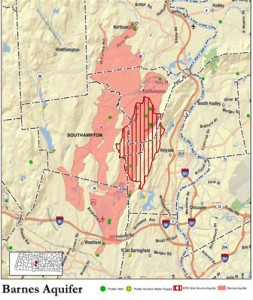WESTFIELD—The Barnes Aquifer Protection Advisory Committee (BAPAC) is expected to give recommendations to the city soon in an attempt to improve the protection of the Barnes Aquifer and other water sources.
The members of BAPAC will be drafting a letter with their recommendations they decided at their regularly scheduled meeting Tuesday. The recommendations discussed at the meeting would be made to try and influence changes to the city’s zoning ordinances.
“We really want to strengthen protection,” Patty Gamborini, BAPAC member, said.
Gamborini outlined several portions of the Westfield zoning ordinance where changes could occur to improve protection of the aquifer, specifically in Article III, Sect. 3-170, of the Westfield zoning ordinance, titled the “water resource protection district.”
According to the ordinance, this district was made to:
“[P]romote the health, safety and general welfare of the community; to protect, preserve and maintain the public water supply and the lands that contribute to it; to conserve the natural water resources within the [c]ity; and to prevent pollution of the public water supply of the [c]ity and surrounding areas.
The changes Gamborini suggested focused mostly on language within the already existing ordinance, and included changes to sections on applicability, definitions and dimensional and coverage requirements.
Among the changes, Gamborini mentioned possibly suggesting the removal of language of special permits in the applicability section, which, according to the current ordinance, “may allow for exemption of any portion of the property not within the delineated Water Resource Protection District from any provision of Section 3-170.”
Another change suggested by Gamborini would be to better define what zones I and II are in the ordinance. Currently, zone I is defined as a “protective radius, typically 400 feet, required around a municipal water supply well or wellfield,” as defined by Massachusetts Department of Environmental Protection (MassDEP) and state drinking water regulations. Zone II is defined as a “recharge area of an aquifer which contributes water to a public drinking water well under the most severe pumping and recharge conditions that can be realistically anticipated,” also defined by state drinking water regulations and approved by MassDEP.
Also, Gamborini and the rest of BAPAC discussed suggesting a change to the “Dimensional and Coverage Requirements” (Sect. 3-170.8) related to “[m]aximum impervious surface of any lot or common development project,” which is currently set at 70 percent of the lot.
According to Gamborini, she believed that the 70 percent number seemed “excessive” and should be looked at more critically.
“Is there any data behind allowing 70 percent,” Gaborini asked. “Is drinking water still protected?”
Gaborini went on and suggested that educational literature related to the topic should be delved into when considering changes to the ordinance.
The letter is expected to be ready for review by BAPAC for their next meeting, which will occur in early April.


